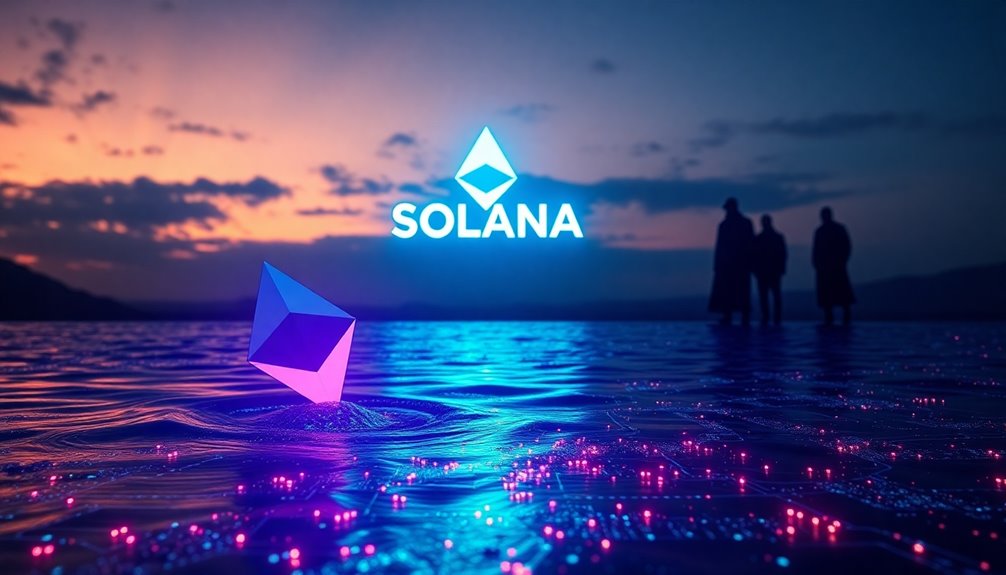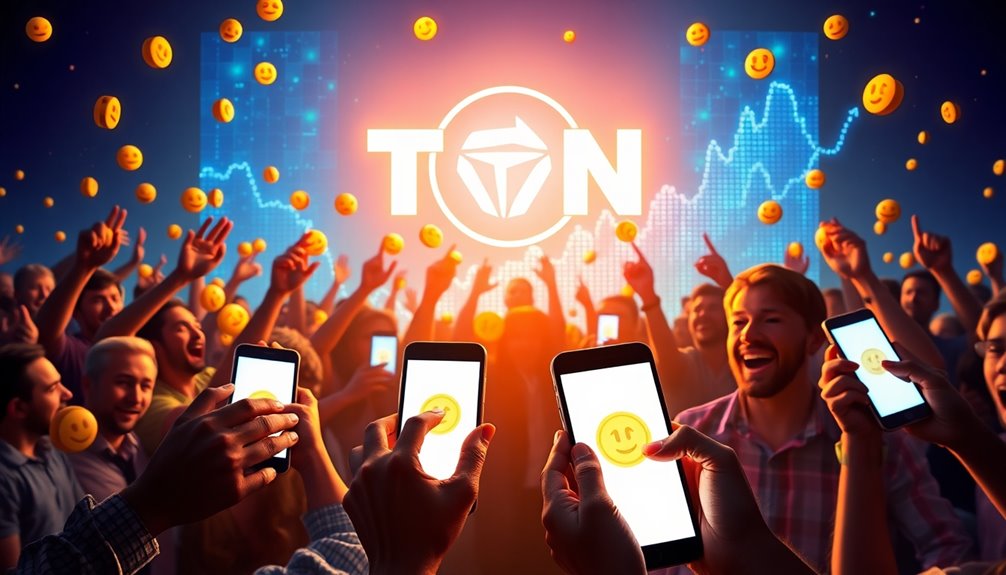Ethereum insiders have raised alarms about Solana's promising rise, noting that its remarkable $100 billion market cap and recent 48% growth could be masking deeper issues. Despite impressive transaction speeds and a large user base, Solana struggles with centralization risks and limited validator participation. The network has a history of outages, raising concerns about its future reliability. As Solana tries to maintain its position against Ethereum's Layer 2 innovations, potential scalability challenges loom. If you're curious about what's next for Solana and the broader market, you might find some intriguing insights ahead.
Key Takeaways
- Solana's high centralization risk, with 98% of SOL supply owned by insiders, raises concerns about its long-term sustainability.
- Historical network outages and recent bugs highlight Solana's stability issues, undermining investor confidence.
- Scalability challenges persist due to hardware requirements for validators, limiting the number of participants in the network.
- Competition from Ethereum's Layer 2 solutions, offering higher throughput and lower fees, poses a significant threat to Solana's market position.
- Ongoing community efforts to address network flaws are crucial for maintaining user trust and preventing potential collapse.
Current Performance of Solana

In the ever-evolving landscape of cryptocurrency, Solana's current performance stands out with its impressive price surge and robust market capitalization. As of November 2024, you'll find Solana trading around $250, having recently surged 48% in just a month. Its market capitalization has soared past $100 billion, bringing it closer to its all-time high of nearly $268 set in November 2021. Significantly, Solana's market cap is only about $20 billion smaller than Tether's, showcasing its prominence in the crypto space.
The network's performance is equally remarkable, processing over 65,000 transactions per second, which is vital for decentralized finance (DeFi) and non-fungible tokens (NFTs). This high transaction speed is a key factor in Solana's growing preference among users compared to other platforms.
With over 25 million monthly active users and $100 billion in decentralized exchange transactions this month, strong activity fuels positive sentiment across the market. Looking ahead, analysts are optimistic about Solana's trajectory, predicting that SOL could reach between $250 and $300 by the end of 2024. The combination of strong adoption and technological enhancements paves the way for continued growth, but external factors like market conditions and regulations will also play a significant role.
Solana vs. Ethereum Comparison

While Solana's current performance showcases impressive growth and strong user engagement, a comparison with Ethereum reveals significant differences that may influence future developments. Here are three key areas where they diverge:
1. Transaction Speed and Fees: Solana processes up to 65,000 transactions per second (TPS) compared to Ethereum's 15-30 TPS.
Solana's fees often remain under a cent, whereas Ethereum's can soar to $50 during peak times. This makes Solana more accessible for everyday users.
2. Ecosystem Maturity: Ethereum boasts a more mature ecosystem with over 1,080 protocols, while Solana has around 194.
Ethereum's larger market capitalization and total value locked (TVL) gives it greater stability, though Solana's TVL has seen significant growth recently.
3. Decentralization and Security: Solana operates with 1,000 to 1,500 validation nodes, while Ethereum will eventually have more than double that number.
Critics argue that Solana's speed might compromise its decentralization and security, raising questions about its long-term viability.
These differences highlight the unique strengths and weaknesses of each platform, shaping their future in the blockchain landscape.
Technological Advantages and Limitations

When you look at Solana's technological landscape, its high transaction throughput stands out as a major advantage, allowing for impressive scalability. The Proof-of-History mechanism enhances this efficiency, but you might also notice that server architecture constraints can pose limitations. Moreover, this blockchain's ability to achieve thousands of transactions per second showcases its potential in high-frequency trading applications. Balancing these strengths and weaknesses is essential for understanding Solana's position in the blockchain ecosystem.
High Transaction Throughput
Achieving high transaction throughput is one of Solana's standout features, drawing attention for its potential to revolutionize decentralized finance. With the ability to theoretically handle over 65,000 transactions per second, Solana's real-world performance averages around 2,000-3,000 transactions per second. This impressive capability comes with several advantages:
- Parallel Transaction Execution: Solana's multi-threaded approach allows multiple transactions to be processed at once, reducing congestion.
- Low Block Times: The network targets a block time of 400 milliseconds, enabling swift transaction confirmations.
- Efficient Fee Structure: Low and predictable transaction fees attract high-frequency users, enhancing payment efficiency. Additionally, monitoring the success rate of transactions provides insight into user experience and network reliability.
However, challenges remain. Network congestion often limits throughput, and complex transactions may experience inefficiencies.
Additionally, the reliance on large servers for validation can hinder performance increases. While Solana's throughput gives it a competitive edge, the landscape is shifting.
Ethereum Layer 2 solutions are developing to potentially surpass Solana's capabilities in both latency and throughput. This could impact Solana's standing in the evolving decentralized finance space, prompting the need for ongoing innovation and adaptation.
Proof-of-History Mechanism
The Proof-of-History (PoH) mechanism offers significant technological advantages that enhance Solana's blockchain capabilities. First, it enables faster transactions by eliminating the need for every node to agree on the order of each transaction, which speeds up processing times considerably. Additionally, PoH is more energy-efficient than traditional mechanisms like Proof of Work, resulting in a lower energy footprint for the network. This efficiency supports scalability, allowing Solana to handle a larger volume of transactions per second, which is vital for real-world applications. Moreover, PoH maintains decentralization, ensuring that no single entity controls transaction processing, thereby preserving trust and security. This leads to a better user experience, as transactions are quicker and more reliable, with reduced waiting times and fees. On the security front, PoH creates an immutable timeline of transactions and uses verifiable timestamps that form a secure chain, making it hard for bad actors to tamper with the history. However, there are limitations, including the complexity of implementing verifiable delay functions (VDFs) and the dependence on network nodes, which could lead to centralization if not managed carefully. Furthermore, the requirement for significant computation in verifiable delay functions could pose challenges for lower-end hardware used by some network participants.
Server Architecture Constraints
Solana's Proof-of-History mechanism provides impressive speed and efficiency, but it also highlights the limitations imposed by its server architecture. While Solana can process thousands of transactions per second, the underlying hardware requirements create significant challenges. Here are some key points to examine:
- High-performance hardware: Validator nodes require fast CPUs (3 GHz or higher) and 256 GB of RAM, while RPC nodes need 500 GB to 1 TB of RAM. This reliance on robust hardware constrains scalability. Additionally, the annual operating cost for a validator is approximately $11,000, which can be a barrier for many potential operators due to the high costs.
- Performance limits: Current server architecture has hit its performance ceiling, making it difficult to achieve substantial throughput increases. Each validation node demands a large server, restricting the network's capacity to grow.
- Centralization risks: The need for top-tier hardware means only a limited number of validators can participate, raising concerns about centralization and security.
As Ethereum Layer 2 solutions emerge, they may surpass Solana's latency and throughput capabilities, further exposing the vulnerabilities in Solana's single-server model.
Understanding these server architecture constraints is essential as Solana navigates its future.
Market Predictions and Insights

Traversing the market predictions for Solana reveals a complex landscape filled with potential and uncertainty. As you look ahead, the price forecasts indicate a bullish trajectory, with considerable fluctuations expected throughout 2024. Here's a snapshot of those predictions:
| Month | Price Range ($) |
|---|---|
| February 2024 | 140 – 160 |
| March 2024 | 160 – 170 |
| April 2024 | 170 – 190 |
| May 2024 | 190 – 220 |
By mid-year, predictions suggest Solana could stabilize between $230 and $250, with an ambitious end-of-year high reaching up to $680. Long-term projections hint at a potential price around $580 to $610 by the end of 2024, setting the stage for even greater heights by 2030. Additionally, the current market cap of Solana reflects its strong presence, which could bolster investor confidence.
However, external factors like Bitcoin's halving and inflation concerns could greatly influence market sentiment. Be mindful of current support at $135; if that's breached, a drop to $130 could follow. Keep an eye on the technical indicators as they suggest possible recovery and momentum, which could shape Solana's near-term future.
Ecosystem Growth and Adoption

As market predictions for Solana suggest a potential bullish trend, the ecosystem itself is experiencing significant growth and adoption. You'll find that activity in the development community is on the rise, with an impressive 11.2% growth in development activity over the past month. This is reflected in the increasing number of contributors, which has grown by 4.2%. More developers mean more innovative decentralized applications (DApps) and solutions.
Here are a few key highlights driving this growth:
- User Base: Solana boasts 600K daily active users, showcasing a strong and vibrant community. Additionally, the importance of secure storage for digital assets is becoming increasingly recognized among users.
- DeFi Boom: The total value locked (TVL) in DeFi has surged by 750% in 2023, reaching $9.4 billion.
- Diverse Applications: Solana is expanding into various sectors like DeFi, NFTs, and payments, attracting a multitude of use cases. This recent increase in development activity indicates a robust infrastructure that enhances both utility and adoption.
With low fees and fast transaction times, it's clear that Solana is positioning itself as a leader in the blockchain space, making it an attractive option for users and developers alike.
Challenges and Future Outlook

As you consider Solana's future, you can't ignore its architectural limitations that may hinder scalability. Layer 2 competition is heating up, and platforms like Ethereum could outpace Solana in speed and efficiency. Additionally, the historical concerns about outages cast a shadow on its reliability, raising questions about its long-term stability. Despite these challenges, Solana has shown it is capable of processing thousands of transactions per second, which could help it remain competitive in the evolving market landscape.
Architectural Limitations Ahead
Solana faces significant architectural challenges that threaten its long-term viability. As you investigate deeper, you'll notice several key issues that could hinder its future success:
- Centralization Risks: With 98% of the initial SOL supply owned by insiders, there's a serious decentralization concern. Coupled with a limited number of validators, this increases vulnerabilities and control points. The increased developer momentum on Solana could be undermined by these centralization issues.
- Complexity and Learning Curve: The sophisticated technology behind Solana can be intimidating. Newcomers and developers often struggle with its complex smart-contract approach, which utilizes two types of accounts and programs, making navigation tricky.
- Network Stability Concerns: Solana's history of outages directly impacts user experience. Recent implementation bugs in the networking stack have raised flags, emphasizing the need for improved reliability.
These architectural limitations not only affect scalability and performance but also make Solana more susceptible to outages and cyber threats.
If Solana doesn't address these challenges, its golden era may be short-lived, leaving users and developers searching for more reliable alternatives.
Layer 2 Competition Rising
The rise of Layer 2 solutions poses a formidable challenge to Solana's dominance in the blockchain space. Ethereum's Layer 2 innovations are achieving throughput that's 100 times higher than Ethereum Layer 1, with the potential to reach 1,000 or even 10,000 times soon. In contrast, Solana's scalability is limited by server performance, making it tough to increase gas limits considerably.
Moreover, Layer 2 solutions are remarkably cost-efficient, slashing transaction fees by an average of 94% compared to Ethereum's mainnet. This cost reduction opens doors to new use cases, particularly in micro-transactions and gaming. For instance, Immutable X provides zero gas fees and instant trades, drawing considerable capital into its infrastructure. Over 100 Fortune 500 companies have initiated L2 blockchain projects in 2024, showcasing the growing interest in these innovative solutions. Additionally, the rise of automated trading tools is further enhancing the efficiency and accessibility of Layer 2 platforms.
Technologically, advancements like proto-dank sharding and zk-rollups are enhancing both scalability and security. The combined total value locked (TVL) in Layer 2 solutions now exceeds $38.3 billion, with daily active users surpassing 2 million. As new entrants like Base capture a growing share of the market, Solana's position may become increasingly precarious. Without considerable innovation, it risks being overshadowed in the rapidly evolving blockchain landscape.
Historical Outage Concerns
Frequent outages have cast a shadow over Solana's reputation, raising serious concerns about its reliability in the competitive blockchain arena. In 2022 alone, Solana experienced 11 significant outages, leading to questions about its long-term viability. The network's on-chain consensus model, which inflates transaction volume, contributes to instability—making it more susceptible to disruptions.
Here are some key facts to examine:
- Outage Frequency: Solana had 11 major and 3 minor outages in 2022, with the most recent major outage lasting five hours in February 2024. Despite these setbacks, the network has managed to remain 262 days without a major outage as of October 25, 2024.
- Impact on Token Price: Outages have caused significant price volatility, including a 9% swing during the February 2023 downtime.
- Validator Communication Issues: Validators often shift to Discord during outages, complicating recovery efforts as two-thirds must agree to restart the network.
While these challenges are serious, recent improvements show promise. The community's quick response to issues and efforts to enhance network stability indicate that Solana could rebound.
If they continue to address these flaws, Solana may still have a shot at growth in the future.
Frequently Asked Questions
What Factors Contribute to Solana's Volatility in the Market?
Solana's volatility stems from several key factors.
Economic conditions like rising interest rates and inflation can dampen investor enthusiasm. Regulatory changes and geopolitical events also play a role in shaping market sentiment.
On the technical side, price fluctuations are influenced by indicators like Fibonacci levels and market volume.
Additionally, competition from Ethereum and concerns over Solana's network performance can fuel uncertainty.
All these elements can lead to rapid price swings in SOL.
How Does Solana's Community Engagement Compare to Ethereum's?
When you compare Solana's community engagement to Ethereum's, you'll notice some key differences.
Ethereum boasts over 200 million unique addresses, reflecting a strong, active user base. Its daily transaction activity exceeds 500,000, indicating robust participation despite market fluctuations.
In contrast, while Solana's user engagement has surged, particularly with high transaction revenues, it still trails Ethereum's established network activity and overall ecosystem maturity, highlighting Ethereum's enduring dominance in community involvement.
What Are the Key Risks for Investors in Solana?
You might think investing in Solana is a sure bet, but there are key risks to take into account.
Network outages and potential vulnerabilities in its consensus mechanism could destabilize the platform.
Plus, you'll face tough competition from established blockchains like Ethereum.
Regulatory uncertainties and market volatility can further complicate things, making it essential to stay informed and diversify your portfolio.
Ultimately, understanding these risks can help you make smarter investment decisions.
Are There Any Notable Partnerships Driving Solana's Growth?
Absolutely, there are several notable partnerships driving Solana's growth.
You've got Franklin Templeton launching a mutual fund, and Societe Generale Forge introducing a Euro-pegged stablecoin. These developments highlight the increasing convergence of traditional finance and blockchain technology, as major players explore innovative ways to bridge the gap between the two arenas. However, the industry still grapples with scandals, such as the recent Celsius CEO fraud confession, which has intensified calls for stricter regulations and heightened scrutiny in the crypto space. As institutions navigate this evolving landscape, the balance between innovation and accountability remains a critical focal point for stakeholders.
Citi Bank's potential integration could streamline transactions, while collaborations with Chainlink and Serum enhance DeFi applications.
Mastercard and Visa are also on board for seamless payments.
These partnerships greatly boost Solana's ecosystem, making it an attractive platform for both investors and developers.
How Does Solana's Environmental Impact Compare to Ethereum's?
Imagine Solana as the eco-friendly superhero, zooming around with its low energy consumption of 0.166 watt-hours per transaction, while Ethereum, in its clunky PoW suit, chugs away, burning more energy.
But wait! Ethereum's getting a makeover, shedding its old ways to become a lean, mean, PoS machine, slashing its energy use by 99.95%.
Conclusion
As you navigate the rapidly changing crypto landscape, keep an eye on Solana's trajectory. While its innovations have spurred impressive growth, the looming challenges could signal a downturn. For instance, if a major project like Serum were to face significant issues, it could shake confidence in the entire ecosystem. Staying informed and adaptable is key—don't let the excitement blind you to potential risks that could impact Solana's future.










